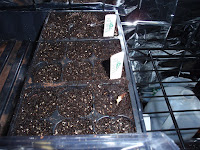I finally got a chance to get into the FVG to look at my plot. Last time I was there it was so covered in snow that I didn't think it would thaw out until April. A day of warmer temps helped uncover the beds... unfortunately just in time to expose them to freezing temps now that they weren't insulated under the snow. Oh well.
Very few losses from the winter. My arbor lost its roof...

I knew that I hadn't secured it properly. Fortunately the wood is still intact and I just need to reattach it with better screws. The gate lost its top shelf which also was on the ground. I'll need to do some aggressive gluing and bolting.

I was surprised to see that my strawberries had overwintered and were already coming up green. I actually had thrown them into the bed replacing spent peppers as a last thought at the end of the season and got a few fall strawberries. I never intended them to stay in the bed. I had a strawberry planter that had succulents in it that I expected to die during the winter and planned to reuse the planter for the strawberries. Neither the succulents nor the strawberries died. I'm sure if I wanted then to survive they wouldn't have. So I'll have to figure out where to put the strawberries since that square foot is already taken for peppers again. I'll leave them until May since I can't plant the peppers till then anyway.
My beds have settled a bit and I can see that some underground munchkin has been at them. I didn't have any problems with burrowers last year and didn't think to put down a mesh underneath my weed blocker. I hope I won't have to dig up all my mel's mix and add chicken wire to the bottom of the boxes.
When it warms up and I go to add my compost to each square for the new season I'll investigate further. It was too cold to do it on the first survey.
Here are the spring cleaning plans:
1) Build the cold frame
2) Repair the tomato trellis
3) Clear away space for another 2x6' raised bed for melons
4) Repair the roof of the arbor
5) Repair the gate
6) Replace the shed roof with a shallow box that can hold soil for wildflower mix
7) Change position of front layered boxes to allow for carrots/leeks
8) Add compost to each square of Mel's mix, water throughly, and cover with greenhouse plastic to warm the soil
9) Replace the area under the tarp in back with a potting shed
10) Add more mulch to the areas between boxes where the weed blocker is showing
11) Pull the wild onions that continue to grow through the weed blocker :(








 Pansy: Swiss Giant Blend (10-20d) and Violas Amber Jewels (7-10d)
Pansy: Swiss Giant Blend (10-20d) and Violas Amber Jewels (7-10d) 



























